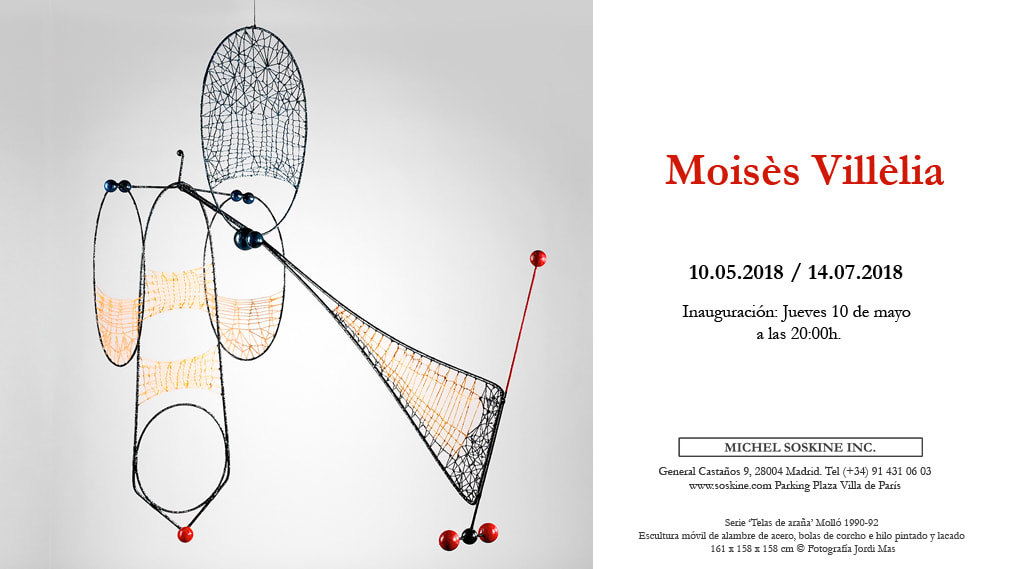Moisès Villèlia
Born in Barcelona (1928-1994)
Michel Soskine Inc. is extremely pleased to present Moisès Villèlia’s (Barcelona1928-1994) second individual exhibition in the gallery with a selection of 12 mobil and static sculptures from the 80s and 90s , including some from the remarkable “ spider web ” series. It is Marcel Duchamp, who, after seeing Calder first aerial sculptures in the 30´s, invented the word 'mobile', a play on words between mobile and mobility.
Ten years before the first manifestations of Arte Povera, in 1956, Moisés Villèlia discovers and elect to work with bamboo, a poor and humble material, organic and hollow, little known in the west. Allied to the concept of dematerialization in XXth century sculpture, Villèlia transforms the bamboo into air sculptures, playing with the balance of its forms, the movements of its various elements floating in air as well as the poetic interplay of its projected shadows on the surrounding walls and ceilings.
With his assemblages of weights and counterweights, Villélia plays with gravity and thanks to the flexible qualities of the material elected, as suggested by art critic Juan Manuel Bonet (...) his sculpture become the protagonist of a poetics of space, drawing in the air lines and shadows, which participate with the gonzalesque idea of sculpture (...). The perpetual movement of mobiles, requires from the spectator a process of active contemplation and playful meditation.
In addition to the material used, the originality of Villèlia's art is characterized by applying touches of color - in particular red and black, by painting or lacquering the threads, wires and some parts of the bamboo cane sculptures. Just as can be found in Egyptian sculpture, or in a Giacometti adding color to his plasters or a Picasso his iron sculptures, Villèlia introduces color as a mean to add an extra dimension that enhances the lines.
Precursor to a certain ecological conscience, Villèlia's work can also be seen as carrying some similar artistic concerns with those of a Giuseppe Penone, who in the 60’s, at a time of strong political and social rejection, chose to work with organic materials, a direct consequence of a general rebuff of consumer society and a search for a deeper and truer relationship with Nature.
By adding a fourth dimension to sculpture, one of movement between space and time, Villèlia explore a new path around the XXth century tradition of abstract sculpture, something also to be found in kinetic art.
Villèlia was an austere, self-contained personage, a friend of artists and poets, profoundly attached to nature and who preferred to remain outside the commercial world of art. A poet and writer as well,his strong personality coupled with an immense energy and independence of thoughts made him reflect on the perspective of sculpture and, a few years after Merleau Ponty famous aesthetic writings, on the phenomenology of perception in art.
Moisès Villèlia learned wood carving in his father´s workshop, a renowned craftsman. With thirteen years, he left school to work in a factory and quickly became interested in poetry starting to carve his first figurative wood pieces. At the age of 26 he held his first solo exhibition at the Mataro museum (near Barcelona) where Joan Brossa visit marked the beginning of a great friendship between the two.
A later exhibition at Barcelona Sala Gaspar Gallery (who represented Picasso) brought the interest of well-known sculptor Angel Ferrant and in 1959 Joan Prats brought Joan Miró, Jacques Dupin and NY gallery owner Pierre Matisse to see Villélia work: All three acquired sculptures.
1969 see him travel to Quito (Ecuador) where he lived until 1972. Upon his return to Spain, Villélia rejoin his old friends Brossa, Tàpies and settles in the small and solitary mountainous village of Molló, a few kilometers from the French border.
Finally Polígrafa publishes in 1974 an extended monography by Maria Lluïsa Borràs and in 1979 the mythical Martha Jackson Gallery in New York, which also represented Tàpies, de Kooning, Christo and Jim Dine decide to organize his first US exhibition.
In 1983, the Joan Miró Foundation in Barcelona organize a retrospective exhibition followed in 1999 by another retrospective at the IVAM museum in Valencia.
Selection of public collections:
MNCARS – Museo Nacional Centro de Arte Reina Sofía, Madrid.
MACBA – Museo de Arte Contemporáneo de Barcelona.
MNAC Museo Nacional de Arte de Cataluña, Barcelona.
Albright-Knox Art Gallery, Buffalo, USA.
Wilhelm Lehmbruck Museum, Duisburg, Germany.
IVAM – Instituto Valenciano de Arte Moderno.
Museo de Bellas Artes de Valencia.
Museo Patio Herreriano, Valladolid.
Museo ARTIUM, Vitoria-Gasteiz.
Colección La Caixa, Barcelona.
Colección del Ayuntamiento de Zaragoza.
Fundación Joan Miró, Barcelona.
The Institute of Aesthetic Research, Tokyo, Japan y USA.
Other private collections in Germany, United Kingdom and France.

